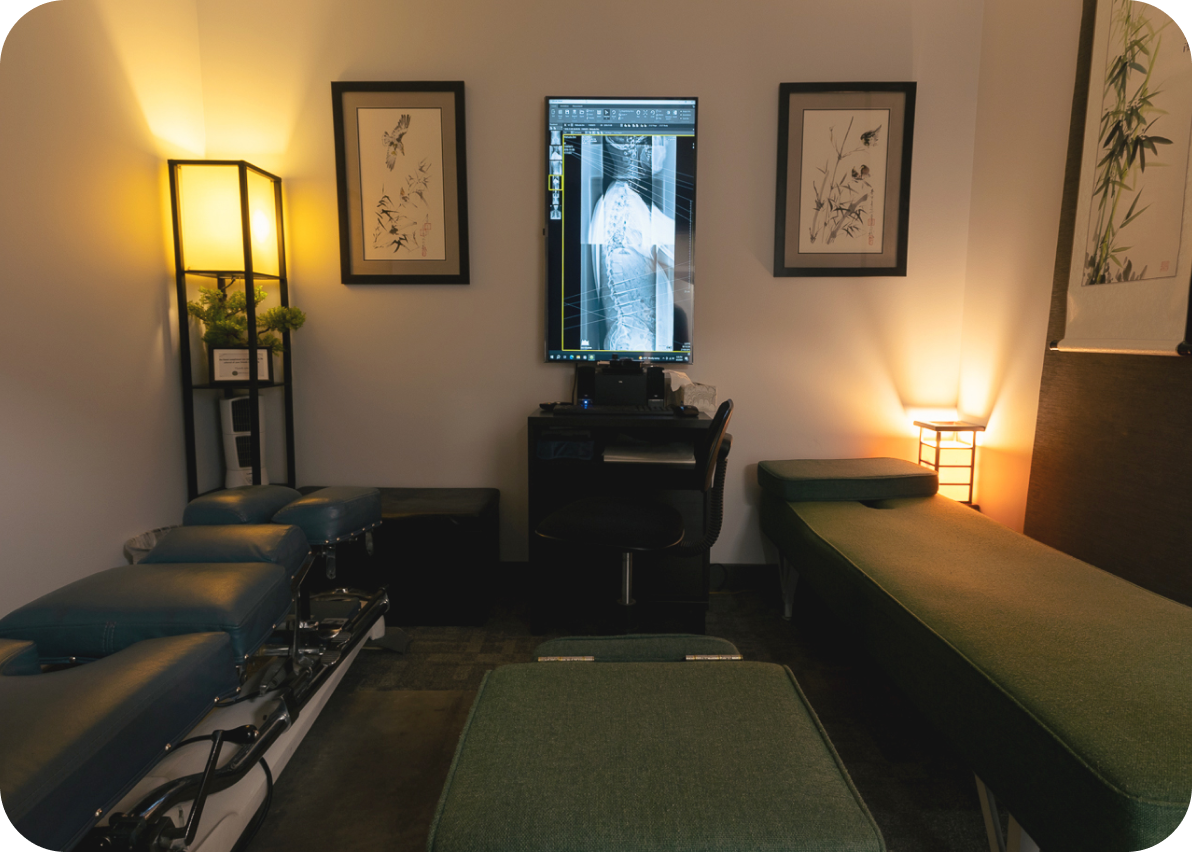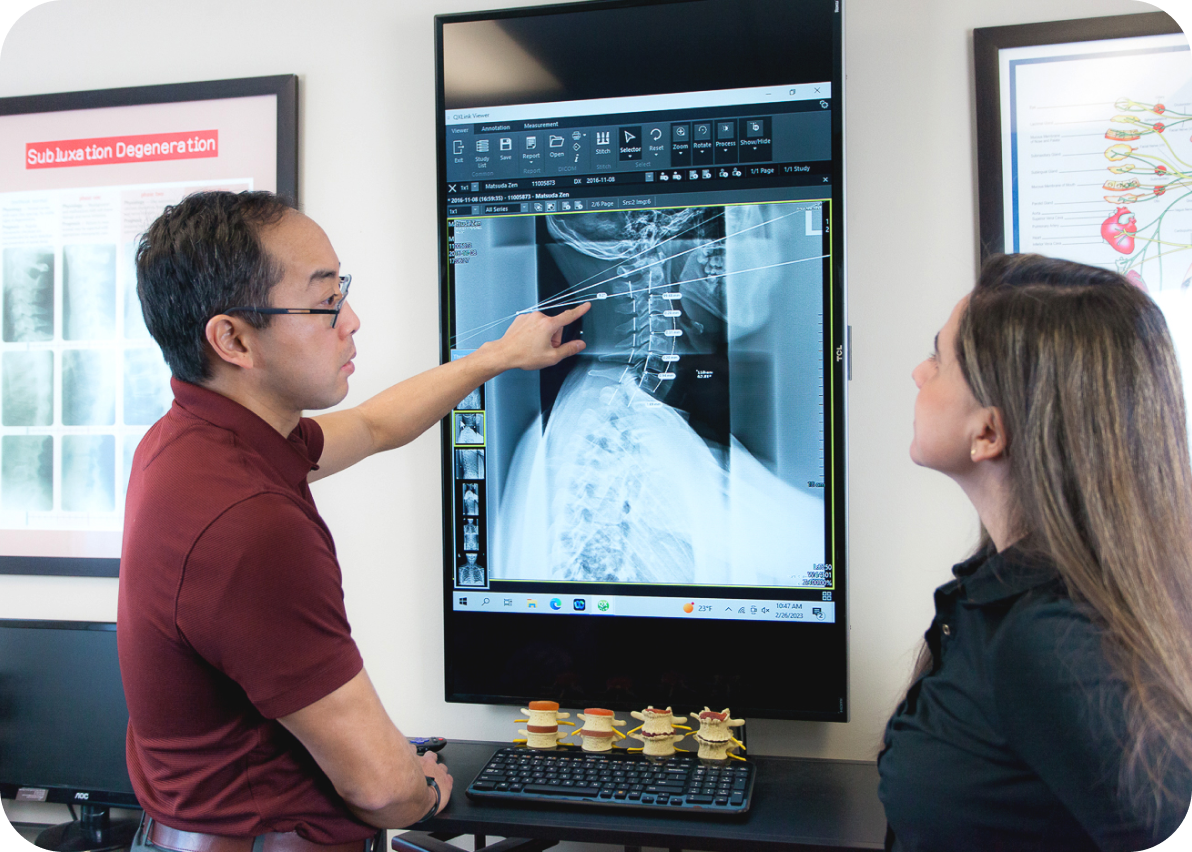First Visit
First Visit
First Visit At Our Clinic
We understand that visiting a new doctor’s office can be daunting, overwhelming, or even unpredictable.
That’s why we strive to create a serene and welcoming environment from the moment you step through our doors.
Your journey begins by reading the Welcome letter from our staff and completing the Health History form. This form covers inquiries about past injuries, previous accidents, and any health-related concerns.
We kindly request that you arrive 10 minutes early to complete the paperwork and expedite the process. Our staff is on hand to engage in a comprehensive and thorough discussion with you.
Following a review of your health history, Dr. Zen at Zen Chiropractic in Eden Prairie will meet with you to discuss your concerns and explore how chiropractic care can benefit you. During your initial visit, Dr. Zen may conduct neurological and radiological examinations as part of the assessment process.

Neurological Exam: Spinal Thermography, SEMG and HRV
We conduct computerized sEMG tests and Heat Index scans to assess muscle balance, a crucial aspect as the proper movement of vertebrae in the spine relies on balanced muscles. When one or more vertebrae are out of position, it disrupts nerve function, leading to muscle imbalance. This imbalance can manifest as abnormal electrical currents in the muscles on either side of the spine, resulting in weakness, tightness, or fatigue. The scan detects increased tension or pull on one side, indicating muscle imbalance.
The Heat Index scan provides valuable insights into Spinal Thermography, sEMG, and HRV to evaluate the autonomic nervous system’s function. Ideally, both sides of the spine should have the same temperature, akin to the body’s core temperature of 98.6 degrees Fahrenheit. Skin, the body’s largest organ, regulates temperature through blood vessel dilation and constriction. Disrupted communication between the nervous system and blood vessels can lead to imbalanced temperature readings along the spine, indicating malfunctioning of the body’s thermostat.
HRV (Heart Rate Variability) testing offers a quantitative assessment of variation in the time interval between heartbeats, providing insights into autonomic function. It aids in detecting autonomic dysfunction associated with various clinical assessments and offers a comprehensive evaluation of a patient’s physiology. HRV testing can help identify conditions like Cardiovascular Autonomic Neuropathy (CAN) and Diabetic Autonomic Neuropathy (DAN), among others.
In summary, Spinal Thermography, sEMG, and HRV testing allow for a thorough evaluation of the autonomic response during long-term health assessments, stress tests, and strategy optimization for longevity and wellness.
Radiological Examination (X-Rays)
Our next step involves taking x-rays, which offer insights into the condition of your spine and guide us in tailoring specific correction methods. Exceptions to x-rays are made for our pregnant patients and children under 7 years of age. We utilize full spine x-rays, providing a comprehensive view of the entire spine on a single film.
Radiological Examination (X-Rays)
Our digital x-ray system utilizes minimal radiation and enhances detail, enabling chiropractors to observe every aspect thoroughly. This advanced technology not only allows us to assess the position of each spinal bone individually but also provides an overarching view of the spine, aiding us in achieving optimal correction.
2nd Visit: Report of Findings
The subsequent appointment holds significant importance as the doctor will thoroughly review your file and discuss the exam results in detail with you. We will examine your x-rays together, allowing you to pinpoint precisely where any issues lie while correlating these findings with the results from the computerized neurological exams. Additionally, during this visit, you will receive your first adjustment.
3rd Visit: Financial Report
During this appointment, we’ll determine the frequency and duration required to optimize your body’s functioning. We’ll assess how your initial adjustment has contributed to your body’s healing process.

Relief Care
This phase aims to alleviate pain, inflammation, and muscle spasms. Treatment may involve ice therapy to reduce swelling and chiropractic adjustments of the spine. This stage typically spans from a few days to a few weeks. Treatment intensity is typically at its peak during this phase, often requiring multiple visits each week for many conditions.
Corrective Care
This phase of care focuses on relieving nerve pressure and restoring normal joint mobility and function. The corrective phase commences once pain has significantly diminished, and the patient feels capable of resuming regular activities. It’s a critical period, as fully resuming all activities prematurely can lead to a return or worsening of symptoms due to the condition not yet being fully stabilized.
During this phase, chiropractic adjustments aim to improve spinal mobility to promote more normal function in the spine and nervous system. The duration of this phase varies, ranging from a few weeks for minor conditions to months for more severe cases. While the frequency of care may still involve multiple visits per week, it typically decreases compared to the acute or relief phase.
Strengthening
In this phase of care, patients typically experience a significant reduction in pain or are completely pain-free in most cases. For severe chronic cases, pain stabilization may continue. The frequency of visits decreases further, while rehabilitative exercises and stretching often become more prominent. Our objective during this stage is to enhance the strength of the soft tissue surrounding the affected spinal segments, promoting consistent function in these areas of the spine.
Maintenance or Supportive Care
This stage marks the point where pain is either completely eliminated or stable in chronic cases. Treatment frequency varies from once per week to once every two months. There are significant benefits at this stage. Typically, patients have developed improved work and exercise habits, promoting overall health. Moreover, patients’ attitudes are generally positive during this phase.
Another notable advantage of this stage is that if a spinal injury occurs again due to unforeseen circumstances, patients often require minimal treatment compared to initial care. This phenomenon mirrors how highly conditioned athletes recover swiftly from injuries that would typically entail prolonged recovery periods for most individuals. Eventually, the body’s natural healing abilities kick in, allowing the spine to maintain and heal itself without the need for chiropractic adjustments.
New CLIENT SPECIAL
Free 15 Minute Consultation
We know that going to a new doctor’s office can be intimidating, we try to create a relaxing and soothing environment from the moment you walk in!
Let us help you on your wellness journey.
"*" indicates required fields
